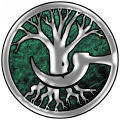Lhiannan: Difference between revisions
| Line 19: | Line 19: | ||
<br> | <br> | ||
== Introduction == | == Introduction == | ||
[[]] | |||
<br> | |||
<br> | |||
The Lhiannan boasted a strange creation story. They | The Lhiannan boasted a strange creation story. They | ||
claimed that their founder — a vampire simply known | claimed that their founder — a vampire simply known | ||
| Line 116: | Line 119: | ||
<br> | <br> | ||
<br> | <br> | ||
== <span style="color:#800000;">'''4th Generation''' == | == <span style="color:#800000;">'''4th Generation''' == | ||
* -- [[The Crone]] -- Presumed progenitor of the Lhiannan bloodline. | * -- [[The Crone]] -- Presumed progenitor of the Lhiannan bloodline. | ||
Revision as of 02:22, 31 August 2015
| Bloodline Disciplines |
|---|
| Animalism |
| Ogham |
| Presence |
The Lhiannan were a territorial, matriarchal and druidic Cainite bloodline who existed in the Dark Ages. Though they are believed to have been an offshoot of Clan Gangrel, they themselves did not believe they were descended from Caine at all, but instead believed they made by "the Crone", a mysterious figure who may be the same Crone mentioned in the Book of Nod.
The Lhiannan have a unique connection to the world of spirits, most notably in the form of their Discipline Ogham.
Introduction
[[]]
The Lhiannan boasted a strange creation story. They
claimed that their founder — a vampire simply known
as the Crone — became bonded with a spirit of the
forests. This spirit was a desperate, jealous being that
could apparently see that people would destroy the forests
and burn the trees that comprised them. Joining
with an undying predator, then, was apparently the
spirit’s attempt at dodging this fate. Whether or not
any of that is true, the Lhiannan did have a connection
to the natural world that no other vampire, not even
the Gangrel, can equal.
Whenever a Lhiannan Embraced, a shard of that original spirit broke off and empowered the new Cainite. This spirit-shard allowed Lhiannan to use their Ogham Discipline, which, in turn, enabled the style of unlife that the Lhiannan enjoyed. It also made the Lhiannan territorial above all else, and the Druids were quite limited in their mobility. The Lhiannan, much like the Telyavelic Tremere (see p. 438) found common cause with the pagan peoples of Europe. This, unfortunately, put them into conflict with Cainites and mortals who followed the Christian faith.
The bloodline was never numerous (especially since creating a new Lhiannan meant that the sire grew weaker), but the fires of the Inquisition and the spread of the Christian religion took a harsh toll on the Druids. By the end of the 14th century, they had all been destroyed. In modern times, though, Gangrel trade rumors of powerful Kindred in European forests decorated with strange, bloody symbols, so perhaps some of them survived — or perhaps the forest spirit that initially created the bloodline has resurfaced.
Nickname: Druids
Sect: The Lhiannan did not survive to see the dawning of the Sabbat or the Camarilla. In historical nomenclature, they were decidedly on the Low Clan side of the social divide, and most Cainites probably wouldn’t have known them from the Gangrel. Lhiannan rarely joined coteries, limited as they were in mobility.
Appearance: The Druids resembled the native people of the regions of Europe that they called home — the British Isles, for the most part.
Haven: The Lhiannan made their havens in the forests of Europe, constructing simple dwellings or finding natural shelter. They would sometimes find a man-made haven and kill or enslave the inhabitants, or very rarely eke out an existence on the periphery of human civilization by taking the role of a shaman or wise woman.
Background: Since performing the Embrace meant growing weaker, the Druids only created childer out of sheer loneliness or when they found someone who truly impressed them. A pagan spirit-speaker with real devotion to her craft, or a woodsman with impeccable respect for the forests might be enough to get a Lhiannan’s attention. The Lhiannan refused to Embrace Christians, Jews, or Muslims.
Character Creation: All Lhiannan were capable of surviving in the wilderness, and so Physical Attributes, Skills, and Talents were important. A Lhiannan acting as a counsel to a mortal settlement was likely to have higher Social Attributes and appropriate Abilities. Herd and Retainers (animals) were common Backgrounds.
Clan Disciplines: Animalism, Ogham, Presence
Weakness: The Lhiannan were part nature spirit, and the mark of their inhumanity ran strong within them. All difficulties to detect their nature via Auspex were reduced by two, and even normal humans felt vaguely uncomfortable in their presence. Additionally, any Lhiannan who left her territory became agitated — all dice pools were reduced by one die per week (to a minimum of the character’s Stamina) that she was gone. Once she re-entered her territory, her dice pools returned to normal within a few hours.
Organization: Once a Lhiannan Embraced a childe,
she generally kept the new vampire around for a few
years until that childe was ready to fend for himself (and
the novelty of having someone else around wore off).
The sire would then send the childe away to find his
own haven and territory. The Lhiannan were generally
aware of members of their bloodline whose territories
were adjacent, but there was no system of communication
in place. This, of course, may have contributed to
their eventual destruction.
4th Generation
- -- The Crone -- Presumed progenitor of the Lhiannan bloodline.
5th Generation
- -- Magda -- Witch of Connaught
6th Generation
- -- Boudicca -- - Priestess of Coventina.
7th Generation
- -- Feidlimid
8th Generation
9th Generation
10th Generation
11th Generation
12th Generation
13th Generation
Those of Unknown Generation
